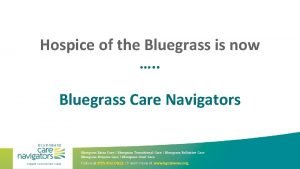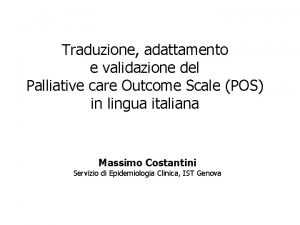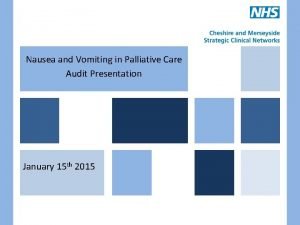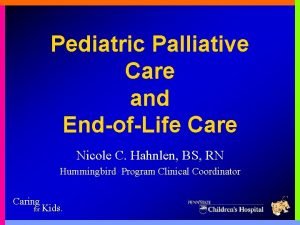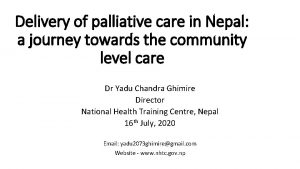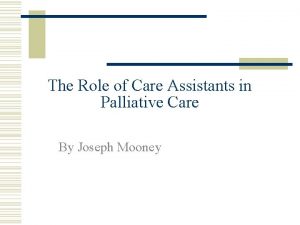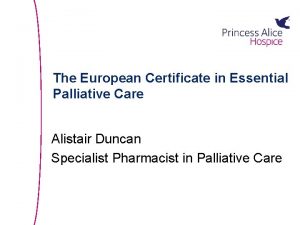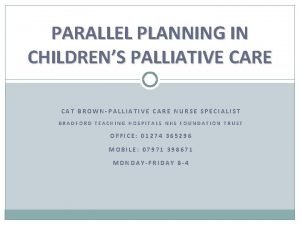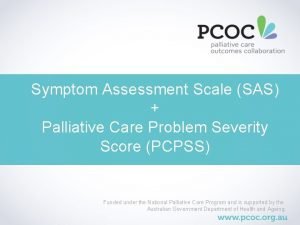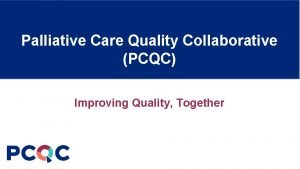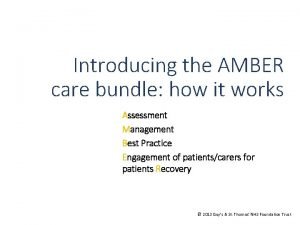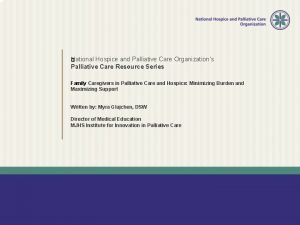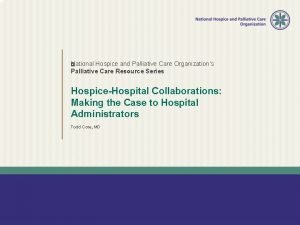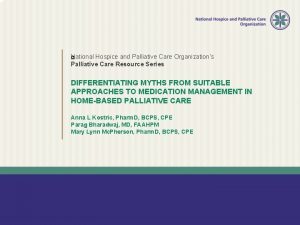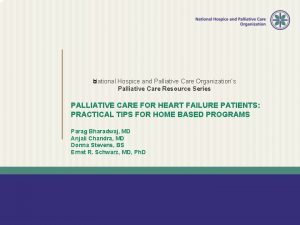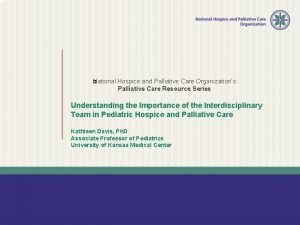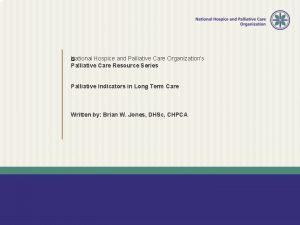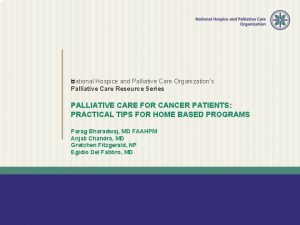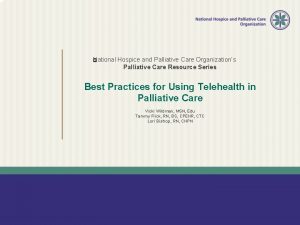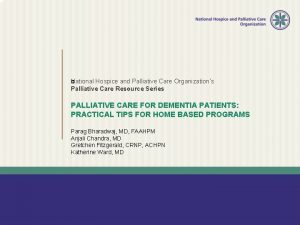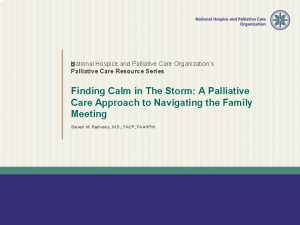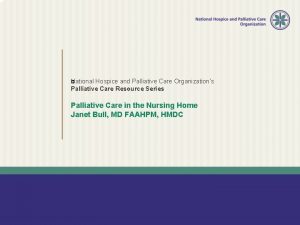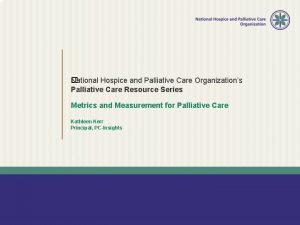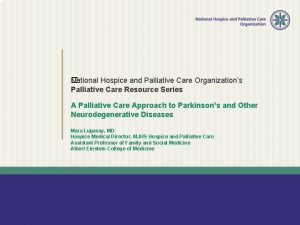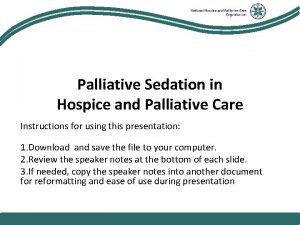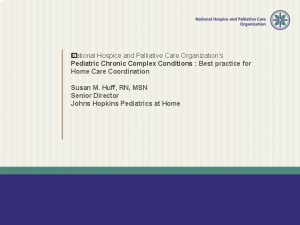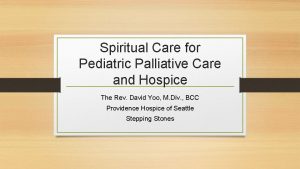National Hospice and Palliative Care Organizations Palliative Care




















- Slides: 20

National � Hospice and Palliative Care Organization’s Palliative Care Resource Series Cannabis Use in Palliative Care: History, Legality and Implications for Practice Written by: Peter A. Radice, MD, FACP, FAAHPM

Objectives • Discuss the history, background, state and federal laws and regulations around the use of marijuana • Understand the Endocannabinoid System (ECS) • Identify the physiological and cognitive effects of cannabis • Describe the routes of administration and dosing of cannabis • List the side effects and contraindications for its use

History of Marijuana • 2737 BC – first recorded medicinal use in Chinese Pharmacopoeia • 1400 BC to AD – trade moves product through India, Mediterranean countries, Europe – numerous medicinal uses reported • Major crop in colonial North America, hemp was grown as a fiber

History of Marijuana • Introduced to North America in 1600’s by Puritans – Hemp for ropes, sails, clothing. Cannabis a common ingredient in medicines, sold openly in pharmacies. • 1937 – Marijuana Tax Act – transfer of cannabis illegal throughout US except for medicinal and industrial use, expensive excise tax and detailed logs required. • The “gateway theory” of marijuana use still prevails.

History of Marijuana • 1970’s – The Controlled Substance Act of 1970 classified marijuana as a Schedule I drug. • 1981 -1993 – Zero tolerance climate of Reagan and Bush Administrations; war on drugs. • 1990’s – Marijuana smoking on upward trend. • 1996 –California becomes first state to legalize marijuana for medicinal purposes.

Cannabis § Complex alkaloid mixture of more than 400 compounds derived from the Cannabis sativa plant. § 60 different compounds described with activity on the cannabinergic system. § Most abundant cannabinoids are: § Delta-9 tetrahydrocannabinol (THC) (most psychoactive) § Cannabidiol (CBD) § Cannabinol (CBN)

Endocannabinoid System • Endogenous agents • CB 1 -present throughout CNS – – – Hippocampus Cortex Olfactory areas Basal ganglia Cerebellum Spinal cord • CB 2 – located peripherally, linked with autoimmune system – Spleen – Macrophages

Cannabis-Based Pharmaceutical Drugs • • Sativex – THC/CBD –Nasal Spray – Neuropathy/Spasticity Marinol – Synthetic THC – Capsule – Cancer/AIDS Nabilone – Synthetic – Capsule – Cancer/AIDS Dexanabinol – Synthetic – Capsule – Traumatic Brain Injury Ajulemic – Synthetic – Capsule – Pain in MS Cannabino – Synthetic – Solution – HTN/Inflammation HU 331 – Synthetic – Solution – Antineoplastic, weight loss, neurodegenerative • RED – Not yet approved

Physiological and Cognitive Side Effects Dependent on many factors: § Dose § Ratio of various cannabinoids used § Route of administration § Timing § Health status of patient § Age of the patient § Co-administration of other drugs § Prior recreational use

Physiological and Cognitive Side Effects • • • Acute cognitive and psychomotor changes Impaired and non-cohesive reasoning Decreased concentration on tasks requiring motor skills Appetite stimulant Anti-emetic properties

Physiological and Cognitive Side Effects • 20%-100% increase in heart rate immediately after smoking • THC/CBD alter hypothalamic/pituitary function • Lowers intraocular pressure

Physiological and Cognitive Side Effects § Studies suggest cannabis intoxication can increase the odds ratio of motor vehicle accidents. § Meta-analysis of long term users consistent with negative neuro-cognitive testing. § Inconclusive about permanent changes in the brain.

Administration and Dosing of Cannabis Products • Smoking or vaporization • Liquid or oil for vaporization, oromucosal, sublingual, tube administration • Patch • Capsules for oral use • Edible products • Rectal suppositories • Ointments, creams, lotions

Administration and Dosing of Cannabis • Route of administration determines pharmacokinetics and effects of the cannabinoids. • Smoking or vaporizing reaches lung alveoli and bloodstream. Psychoactive effects occur in 90 seconds, max at 15 -30 minutes and taper off 2 -3 hours. • Water pipe removes gas toxins.

Administration and Dosing of Cannabis • Vaporization causes more rapid delivery, higher concentrations, less risk of byproducts inhaled. • Oral – psychoactive effects at 90 minutes, max of 2 -3 hours, lasting 4 -12 hours. – Drawbacks – delayed onset of action, variable gut availability, first pass metabolism, difficulty with vomiting and anorexic patients, regulating difficulty.

Administration and Dosing of Cannabis • Significant variation of cannabis types • Limited pharmacological data and lack of uniformity of studies in humans • Tolerance and adverse effects are variable • Personal variation in metabolism

Administration and Dosing of Cannabis • Physiological changes in ECS • Different physiological responses in differing medical conditions • Drug-drug interactions

Contraindications • Absolute – Any patient with psychotic illness – THC is associated with aggravating or precipitating psychotic episodes – THC is a vasodilator, increasing cardiac demand

Contraindications • Relative – Primary liver, renal and pulmonary diseases or a past history of seizures or drug abuse • Close monitoring of symptoms • Patients with COPD and asthma, avoid smoking • Special precautions in pediatric and elderly patients • Minimize drug interactions • Cannabis reinforces sedative effects of other sedative-hypnotics, benzodiazepines and alcohol

Summary • Recent trend in state legislatures is to pass rules and regulations to allow medicinal marijuana - trend continues. • Use in PC is evident in patients with cancer, neurodegenerative diseases, inflammatory diseases, end -of-life angst, uncontrolled seizures and HIV cachexia. • Further study is needed.
 Palliative care vs hospice care
Palliative care vs hospice care Franciscan palliative care
Franciscan palliative care National palliative care research center
National palliative care research center Hospice of the bluegrass
Hospice of the bluegrass Outcome measures traduzione
Outcome measures traduzione Nausea and vomiting in palliative care powerpoint
Nausea and vomiting in palliative care powerpoint Esas-r
Esas-r Rug adl score
Rug adl score Hospice satisfaction survey
Hospice satisfaction survey Principles of palliative care
Principles of palliative care Palliative care in nepal
Palliative care in nepal Palliative care assistant
Palliative care assistant European certificate in essential palliative care
European certificate in essential palliative care Parallel planning palliative care
Parallel planning palliative care Sas scale
Sas scale Pcqc registry
Pcqc registry Just in case bag palliative care
Just in case bag palliative care Amber care meaning
Amber care meaning Goscote palliative care centre
Goscote palliative care centre Barry laird
Barry laird Calvary palliative care
Calvary palliative care



